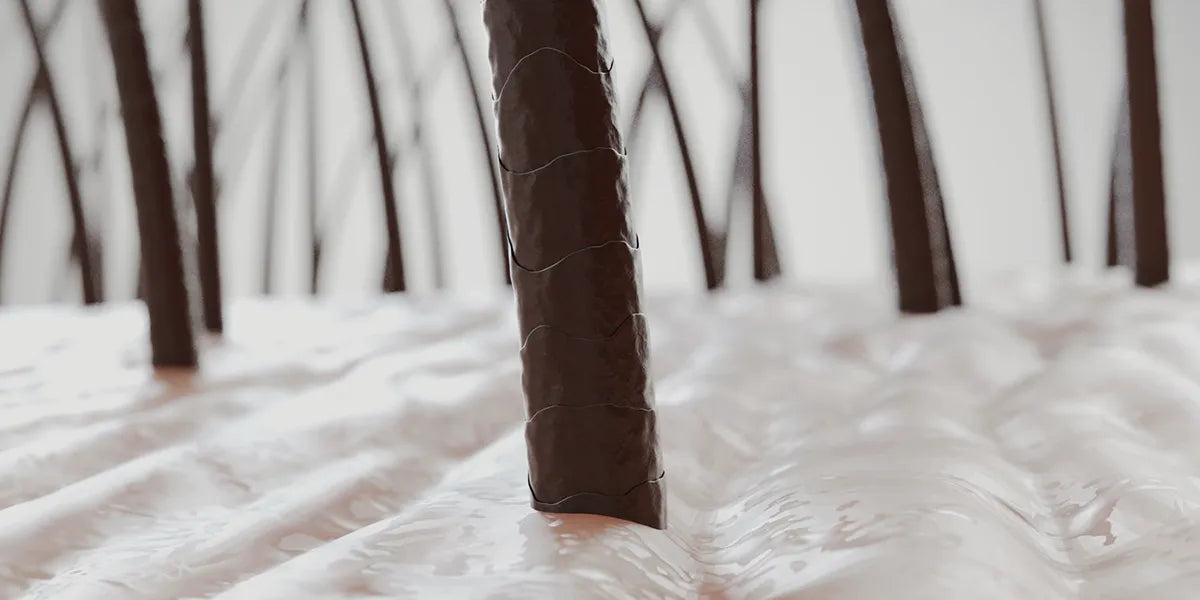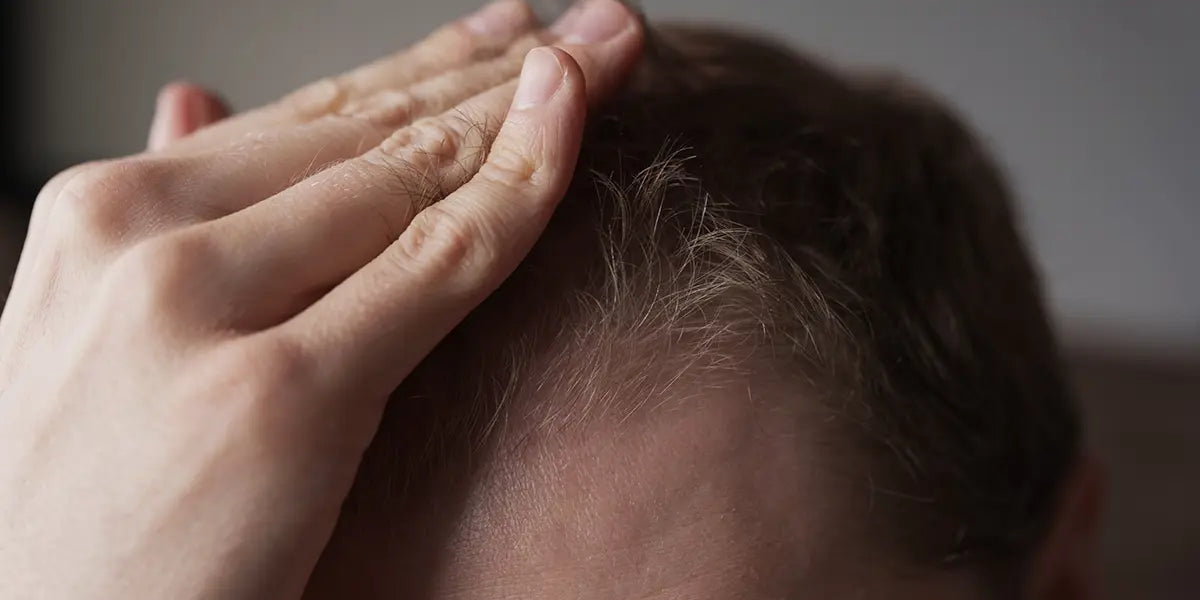What is the hair growth cycle?
The hair growth cycle describes the process through which the hair follicle produces a healthy hair. It involves three main stages: anagen (active growth), catagen (regression) and telogen (rest). In addition to these three main stages, some clinicians also refer to a fourth phase called exogen, which is when the existing hair is shed.
How long is the hair growth cycle?
The entire hair growth cycle can last up to 10 years. Individual hairs spend a predetermined amount of time in each of these stages before they're shed to make room for new hairs. The length of each of these phases depends on a number of factors, including adequate nutrition and hormone levels (Houschyar et al., 2020). Certain medical conditions and medications can also affect the hair growth cycle.
What are the stages of the hair growth cycle?
There are three main stages of hair growth. The hair follicle cycles continuously through these stages.
Anagen: the active growth stage
Anagen is a time of active hair growth and can last anywhere from 2-7 years. This is the stage when hair lengthens visibly at a rate of about half an inch per month as a result of rapid cell division and growth occurring within the hair follicle. Approximately 90% of hairs on the scalp are in this stage of growth.
The length of time that a hair spends in the anagen stage has a direct effect on the final length of the hair strand. It's partly influenced by genetics and is one of the reasons why eyelashes and eyebrows are significantly shorter than the hair on your head.
Research has found that the transition from the anagen to catagen stages may be influenced by a group of hormones called prostaglandins, which have been shown to increase significantly in concentration before the catagen phase (Nieves & Garza, 2014).
Catagen: the regression stage
Next is the catagen stage, which is shorter and lasts only about 2-3 weeks. The mature hair stops growing as cells within the lower and outer portions of the follicle begin to die. Approximately 5% of hairs on the scalp are in this stage of hair growth.
Under a microscope, we see that the lower region of the follicle starts to shrink and fold onto itself (Stenn & Paus, 2001). It gradually detaches from its blood supply and cells at the base of the hair smooth over. At this point the hair is referred to as a club hair.
This club hair stays attached to the scalp via a structure called an epithelial strand. It's a highly specialized piece of tissue that holds the hair in place until it is eventually shed.
Telogen: the rest stage
The telogen stage of the hair growth cycle is also referred to as the rest stage and normally lasts a few months. During this stage, the club hair is slowly pushed through the upper layers of the scalp as new cells within the bulb start to clump together and form the next hair. Approximately 10% of hairs on the scalp are found in this stage of the hair growth cycle.
As new cells accumulate, the hair follicle slowly regains its original shape. They'll eventually re-enter the anagen stage and begin a new growth cycle.
You may have also heard of a fourth phase called exogen. Exogen describes the actual shedding of the club hair rather than a phase associated with the hair follicle.
The hair follicle and its role in the hair growth cycle
The hair follicle undergoes physical changes as it moves through the hair growth cycle. This mini organ can be broken up into two main parts that each passes through different layers of scalp tissue. The upper region of the hair follicle crosses the epidermis (the uppermost layer of skin) and the lower region (the bulb) extends into the layer underneath it called the dermis.
The hair bulb contains rapidly dividing cells that eventually become part of the visible hair shaft. This is especially important during the anagen stage, when hairs grow at a rate of about half an inch per month. These cells and the hair follicle are kept alive by the dermis which contains a network of blood vessels.
The dermal papilla
At the base of the bulb is a group of cells called the dermal papilla. The dermal papilla is the key to hair growth. It provides a constant blood supply to the developing hair during active growth. It also facilitates cell-to-cell communication within the hair follicle (Chen et al., 2020). This communication helps coordinate progress through the different stages of the hair growth cycle.
The hair bulge
During active growth, dermal papilla cells interact with a pool of stem cells found in an area of the hair follicle called the hair bulge. The bulge is located at roughly the halfway point between the upper and lower parts of the hair follicle.
These stem cells eventually become part of either the outer hair bulb or inner hair shaft. With time, this process is visible as the lengthening and thickening of hair strands.
The inner and outer root sheaths
The inner sheath of the hair follicle contains several sublayers including the cuticle, a layer of cells arranged in a scale-like pattern. Over time, the cuticle and nearby outer layers fill with keratin which is the protein which gives hair strength and flexibility.
A structure called the outer sheath surrounds the entire bulb. It functions as the attachment site for small muscles that control piloerection (how hairs stand-up in response to stimuli) and oil-producing glands (Brown & Krishnamurthy, 2021). There is some research suggesting that hair loss disorders such as androgenetic alopecia (male pattern hair loss) involve the weakening of this attachment site over time, which leads to visible thinning and eventually balding (Sinclair et al., 2015).
What can go wrong with the hair growth cycle?
Disruptions to the hair growth cycle can lead to premature hair thinning and/or hair loss. There are a few hair loss disorders that are related to problems with the anagen and telogen stages of hair growth.
In some men, the binding of DHT to hormone receptors on dermal papilla cells located in the hair follicle can shorten the active growth phase and prolong the rest phase (Chen et al., 2020). When this affects a large number of hair follicles, the result is the characteristic thinning seen with male pattern hair loss (androgenetic alopecia).
Another abnormality of the anagen stage is a condition called anagen effluvium. This is a rare type of hair loss that affects hairs that are actively growing. These hairs are shed before they have a chance to fully develop. This is most often observed in individuals diagnosed with alopecia areata (an autoimmune disorder) or those undergoing chemotherapy treatment.
When the telogen stage is affected, hair loss is referred to as telogen effluvium. This is most often cause by sudden changes to health or psychological stress. Stress causes hair follicles to enter the rest stage early and hairs are shed shortly after.
Each of these hair loss conditions is treated in a specific way. We recommend that you speak to your doctor if you notice any unusual changes in hair growth.
The hair growth cycle: Takeaway
The hair growth cycle is a coordinated process that consists of three primary stages. It helps ensure the proper growth and development of mature hair strands and the continued production of new hairs. But it's a sensitive process that may be influenced by genetics, medical and environmental factors.
If you're noticing changes in hair growth or hair texture, you may want to speak to a doctor about possible underlying causes. In most cases, if hair growth issues are identified early and treated (if necessary), normal hair growth can resume.




